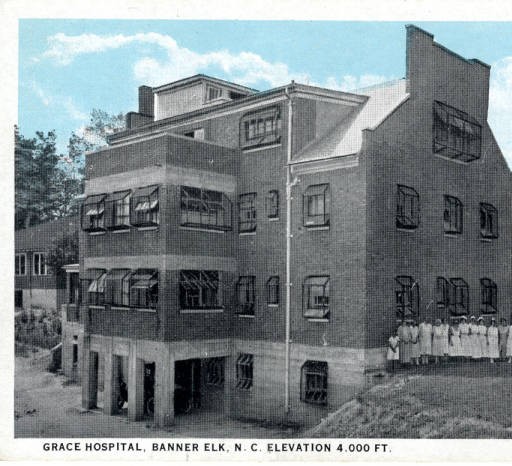Grace Hospital
Introduction
Text-to-speech Audio
Images
Historic Photo of Grace Hospital Nursing School before it was converted to Cannon Memorial.

Backstory and Context
Text-to-speech Audio
Banner
Elk’s Grace Hospital began in 1908 as nothing more than a small building with
five rooms: two patient rooms, a laboratory, an operating room, and a
physician’s residence. Reverend Edgar Tufts, one of the founders of
nearby Lees-McCrae College and a leader of the local Presbyterian Church,
prayed for a physician to arrive in Banner Elk to “render the care and services
of a Christian doctor” (Pollitt & Moore, 1992). It was Dr. Charles Reed who
first arrived to answer Tufts’ prayers, though he was replaced by Dr. William
Cummings Tate 2 years later, in 1910. Dr. Tate and his wife both lived in the
hospital, where in the early 20th century, only the most urgent
cases were treated; most patients at this time were visited at their homes, even if that meant just one physician to care for an entire township without
paved roads.
By 1923, the humble Grace Hospital was averaging five patients a night and was in dire need of expansion. A close friend of Dr. Tate's, Mrs. Helen Hartley Jenkins, heard of his exhaustive work in Banner Elk and subsequently donated $22,000 to build a twenty-five-bed hospital. Construction of the new building was soon after completed; the building was complete with running water, electricity (however faulty), and a coal-fired furnace. Mary Chappel, one of the first nurses to work at Grace, recalls administering anesthesia while “Granny” Bradley, who lived next door, held “a flashlight to supplement or supply the light by which the doctors operated” (Pollitt & Moore, 1992).
A second physician, Dr. Rhonda Hardin, arrived in Banner Elk in 1925 to help manage Grace’s rapid success. By 1932, the hospital accepted its first “class” of nursing students - official nursing training began in 1924, however it was only provided to individuals. The hospital’s success continued until, in 1949, there were not enough physicians to keep training and the nursing school moved. Grace, as a patient care facility, continued to grow and was eventually replaced by Charles A. Cannon, Jr. Memorial Hospital in 1962.
Cite This Entry
Kyle McQueen and Mark Nunes. "Grace Hospital." Clio: Your Guide to History. October 31, 2017. Accessed August 13, 2025. https://theclio.com/entry/48048
Sources
Pollitt, P.A. and K.M. Moore. Appalachian Health Care: The Grace Hospital School of Nursing. American Presbyterian, 1992.

